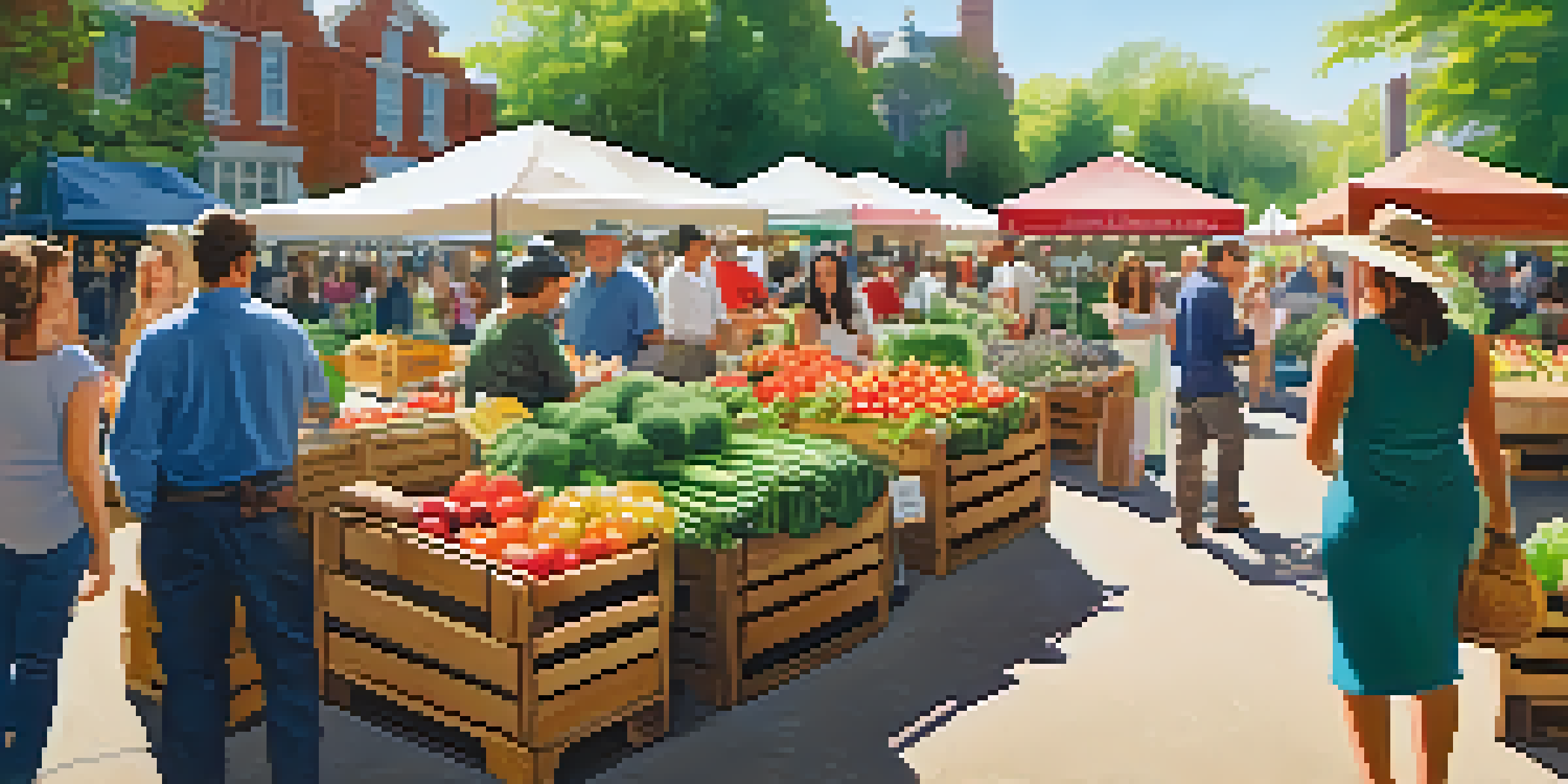The Impact of Health Food Trends on Local Food Cultures

Understanding Health Food Trends and Their Rise
Health food trends often emerge from a growing awareness of nutrition and wellness. As more people seek to enhance their diets, foods labeled as 'superfoods' or 'organic' gain popularity. These terms resonate with health-conscious consumers who are eager to make informed choices about what they eat.
Let food be thy medicine and medicine be thy food.
In recent years, trends like plant-based diets and gluten-free options have surged, reflecting a shift in dietary preferences. These trends not only cater to specific health needs but also promote a lifestyle that prioritizes wellness. Consequently, they influence what products are available in local markets.
As these trends gain traction, they lead to changes in local food production, with farmers and vendors adapting to meet consumer demands. This evolution opens up opportunities for innovative food businesses, allowing them to thrive in a rapidly changing culinary landscape.
How Global Trends Influence Local Cuisines
The impact of global health food trends can be seen in local cuisines, which often incorporate new ingredients and cooking methods. For instance, the rise of quinoa and avocado, once considered niche, has now found its way into traditional dishes across various cultures. This fusion creates exciting new flavors while still honoring local traditions.

Local chefs often experiment with these health trends, creating unique dishes that reflect both global influences and regional ingredients. This blending can lead to culinary innovation, where traditional recipes are reimagined to align with contemporary health trends. As a result, local cuisines become dynamic, evolving to stay relevant.
Health Trends Shape Local Cuisines
Global health food trends influence local cuisines, leading to a fusion of traditional dishes and modern health-conscious ingredients.
However, this can also lead to a tension between preserving authentic recipes and embracing modern health trends. Communities may struggle with balancing their culinary heritage with the desire for healthier options, sparking discussions about what it means to be 'authentic' in a world filled with influences.
The Role of Social Media in Food Trends
Social media plays a significant role in shaping health food trends, with platforms like Instagram and TikTok influencing what people eat. Food bloggers and influencers showcase vibrant, healthy meals that appeal to followers, encouraging them to try new ingredients and cooking styles. This visibility can amplify health trends, making them more appealing to the masses.
You are what you eat, so don't be fast, cheap, easy, or fake.
As a result, local restaurants and food vendors often feel the pressure to adapt their menus to include trendy items. The desire to capture the attention of social media users can lead to creative presentations and innovative dishes that feature health-conscious ingredients. This adaptation showcases local talent while fostering a culture of experimentation.
However, the fast-paced nature of social media can sometimes lead to the commodification of local cuisines. Traditional dishes may be altered or simplified to fit aesthetic trends, raising concerns about authenticity and the preservation of cultural heritage. This dynamic can create a complex relationship between tradition and modernity.
Local Food Movements and Sustainability
Health food trends often intersect with local food movements, promoting sustainability and environmental awareness. Consumers increasingly seek out locally sourced ingredients, which supports regional farmers and reduces the carbon footprint associated with food transport. This shift not only benefits local economies but also fosters a closer connection between consumers and the food they eat.
Many health trends emphasize organic and sustainable farming practices, encouraging communities to prioritize the quality of their food. This focus can lead to an increase in farmers' markets and community-supported agriculture (CSA) programs, where people can access fresh, seasonal produce directly from local growers. Such initiatives promote a healthier lifestyle while bolstering local food systems.
Social Media Drives Food Innovation
Platforms like Instagram and TikTok push local restaurants to adapt their menus, blending creativity with health trends to attract attention.
Incorporating sustainability into health food trends can also inspire innovation in cooking and preparation methods. Chefs and home cooks alike may explore creative ways to utilize every part of an ingredient, reducing waste and promoting a more mindful approach to eating. This ethos not only supports health trends but also nurtures a sense of community and responsibility.
The Challenge of Maintaining Cultural Identity
As health food trends gain popularity, there's a growing concern about the potential loss of cultural identity in local cuisines. Traditional dishes, often rich in history and significance, can be overshadowed by the allure of trendy health foods. This phenomenon raises questions about the preservation of culinary heritage amidst changing preferences.
Communities may feel pressured to adapt their traditional recipes to align with health trends, which can dilute the cultural significance of those dishes. For instance, a beloved recipe may be modified to reduce calories or eliminate certain ingredients, leading to debates about authenticity and tradition. This challenge necessitates a delicate balance between adaptation and preservation.
Ultimately, it’s crucial for communities to engage in conversations about their culinary identity. By acknowledging the value of traditional recipes while embracing healthy innovations, local cultures can create a vibrant food landscape that honors their past while looking toward the future.
Consumer Education and Awareness
Consumer education plays a vital role in navigating the impact of health food trends. As people become more aware of nutritional information, they are better equipped to make informed choices about their diets. This awareness can help them discern between genuine health benefits and marketing gimmicks that often accompany health food trends.
Knowledge about local food systems and sustainability can empower consumers to support local farmers and businesses. By understanding the benefits of eating seasonally and locally, individuals can contribute to the preservation of their culinary heritage while promoting healthful eating practices. This education fosters a sense of community and encourages responsible consumption.
Sustainability and Local Sourcing Matter
The focus on health food trends supports local food movements, encouraging sustainable practices and a deeper connection between consumers and their food sources.
Moreover, educational initiatives can bridge the gap between traditional and modern cooking methods. Workshops and cooking classes can teach individuals how to incorporate health trends into their cooking without sacrificing authenticity. This approach not only enhances culinary skills but also reinforces the importance of cultural identity in food.
Looking Ahead: The Future of Food Cultures
As we move forward, the intersection of health food trends and local food cultures will continue to evolve. The increasing globalization of food means that cultural exchanges will likely produce even more innovative culinary experiences. Communities will need to navigate these changes while holding onto their unique culinary identities.
The emphasis on health and wellness is expected to persist, driving consumers to seek out food that aligns with their values. Local food cultures may adapt by integrating health trends that complement traditional practices, resulting in a richer and more diverse culinary landscape. This adaptability can lead to the emergence of new food movements that celebrate both health and heritage.

Ultimately, the future of food cultures will depend on the ability of communities to balance tradition with innovation. By fostering dialogue and collaboration among chefs, consumers, and local producers, we can ensure that the rich tapestry of local cuisines continues to thrive in an ever-changing culinary world.